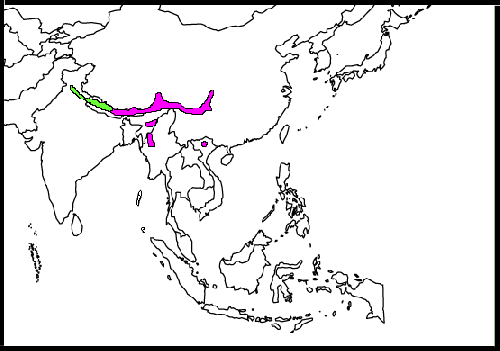Includes: Chinese Cupwing (Chinese Wren-Babbler).
Alternative names: Eastern Scaly-breasted Wren Babbler; Greater Scaly-breasted Wren Babbler; Scaly-breasted Wren; Scaly-breasted Wren Babbler
- Pnoepyga albiventer
Identification
A small (8.5 - 10cm), almost tailless Babbler with a dark and a pale morph.
Pale morph:
- Crown and upperparts olive-brown
- Vague dark scaling on upperparts
- Chin and throat white with slight dark scaling
- Belly and breast white with scaling
- Head side brownish-olive with white shaft streaks
Dark morph:
- Upperparts darker olive-brown, white replaced with fulvous
Sexes are similar. Beware of confusion with similar Nepal Cupwing and Pygmy Cupwing.
Distribution
| Found in the Himalayas from Himachal Pradesh (India) east to Nepal, Sikkim, Bhutan, Arunachal Pradesh onward to Xizang, Sichuan and Yunnan in China. Also in the Northeast Indian Hill states, locally in Northwest Myanmar and Northern Vietnam (Tonkin). Common in parts of its range. | |
| Legend • P. a. pallidior; year-round |
Taxonomy
Clements3 accepts three subspecies:
- P. a. albiventer in the eastern part of its range
- P. a. pallidior in the western part
- P. a. mutica in south-central and central China
The subspecies formosana of Pygmy Cupwing were formerly placed in this species but is now accepted as a full species Taiwan Cupwing Pnoepygna formosana.1. Birds from China were formerly split as Chinese Cupwing (Chinese Wren-Babbler), Pnoepyga mutica.
Habitat
Occurs near water in damp, shady places. Broadleaf forest, fir forest, hemlock or birch forest, forest edge, wet ravines and in waist-high fern growth. During breeding season between 2400 - 3900m, in winter down to 275m.1
Behaviour
Usually found in pairs during the breeding season and single in winter, mostly on the ground where it feeds on insects and seeds. Creeps through undergrowth, nervously flicking its wings.
Breeding season from March to August. Nest built in moss on ground, rock or on trunk of large tree, looking very similar to nest of Northern Wren. Lays 2 - 5 eggs.
Resident species with some altitudinal movement.1
References
- Del Hoyo, J, A Elliott, and D Christie, eds. 2007. Handbook of the Birds of the World. Volume 12: Picathartes to Tits and Chickadees. Barcelona: Lynx Edicions. ISBN 978-8496553422
- Rasmussen, PC and JC Anderton. 2005. Birds of South Asia: The Ripley Guide. Barcelona: Lynx Edicions. ISBN 978-8487334672
- Clements, J. F., T. S. Schulenberg, M. J. Iliff, T. A. Fredericks, J. A. Gerbracht, D. Lepage, S. M. Billerman, B. L. Sullivan, and C. L. Wood. 2022. The eBird/Clements checklist of Birds of the World: v2022. Downloaded from https://www.birds.cornell.edu/clementschecklist/download/
- Gill, F, D Donsker, and P Rasmussen (Eds). 2023. IOC World Bird List (v 13.2). Doi 10.14344/IOC.ML.13.2. http://www.worldbirdnames.org/
Recommended Citation
- BirdForum Opus contributors. (2025) Scaly-breasted Cupwing. In: BirdForum, the forum for wild birds and birding. Retrieved 10 May 2025 from https://www.birdforum.net/opus/Scaly-breasted_Cupwing
External Links
GSearch checked for 2020 platform.1





